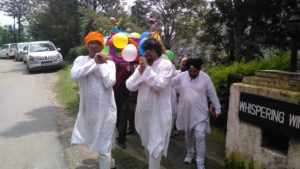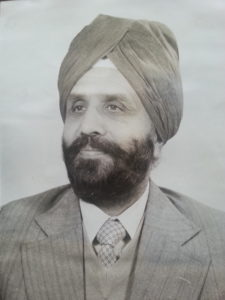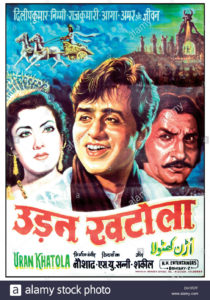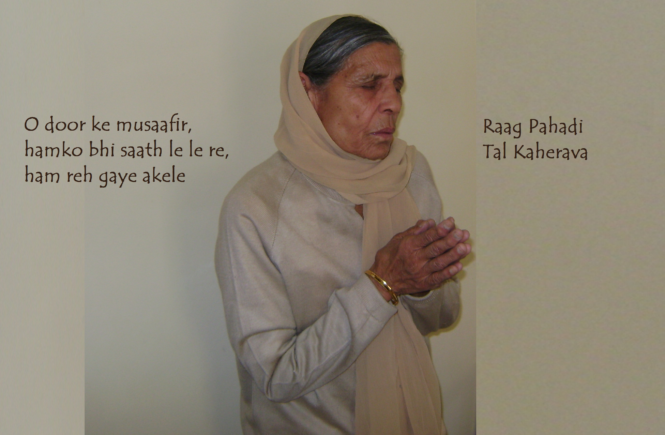Raaga Based Song of the Day: O door ke musaafir hamko bhi saath le le re, ham reh gaye akele….
Raag Pahadi, Tal Kaherava
I gave you the last raaga based song of the day on 31st Jul 17, which happened to be on the death anniversary of the greatest Indian playback singer: Mohammad Rafi (Please read: ‘Raaga Based Song Of The Day #54’). I wasn’t able to put up anything for the last three weeks because my mother – hale and hearty – suddenly took ill and passed away on the morning of 09 Aug 17. On Sunday, the 20th Aug 17, we had Antim Ardaas (Farewell Prayer) for her (Please read: ‘Mom’s Antim Ardaas‘) and now I am back with you with the raaga based songs of the day. The first one is a tribute to her. It happens to have all my favourites: my favourite Raag Pahadi and my favourite quartet: Shakeel Badayuni as Lyricist, Naushad Ali as Composer and Music Director, Mohammad Rafi as Singer, and finally Dilip Kumar as Actor (Please go through: ‘The Best Of Old Hindi Songs: Rafi, Shakeel, Naushad and Dilip Kumar Together‘).
I physically lost my mother. However, I rediscovered my younger brother JP Singh during this period. He is the Chair & Professor of Cultural and Political Economy and Director, Institute of International Cultural Relations (IICR) at the University of Edinburgh. During his childhood, I was not just an elder brother to him but a guardian. I used to make up and sing lullabies to him, the favourite one being:
“Bade bade, bade bade, sher cheeteh aaye,
Hamara Sweety (my nickname for him) darr kyun jaaye?”
 My redicovery of him included learning about his abiding interest in old Hindi movies and songs. After the Antim Ardaas, on the night of 20th/21st Aug, we sat together to listen to songs and ghazals of Shakeel Badayuni. JP brought out that he had done eight years research on Shakeel’s song in Mughal-e-Azam that resulted in his most widely read piece on the song ‘Pyar kiya to darna kya’:
My redicovery of him included learning about his abiding interest in old Hindi movies and songs. After the Antim Ardaas, on the night of 20th/21st Aug, we sat together to listen to songs and ghazals of Shakeel Badayuni. JP brought out that he had done eight years research on Shakeel’s song in Mughal-e-Azam that resulted in his most widely read piece on the song ‘Pyar kiya to darna kya’:
A Subaltern Performance: Circulations of Gender, Islam, and Nation in India’s Song of Defiance
Of course, he is an academician and hence his piece has superb erudition about it as compared to any of my ordinary and somewhat infantile efforts.
As you are aware, on 31st Jul, when I put up the last raaga based song: Yaad na jaaye beete dilon ki in Raag Kirwani, Tal Kaherava, we completed fifty-four days of Raaga Based Songs of the Day. Our first post in the series was titled ‘Raaga Based Song Of The Day #1’ and the song was a Mohammad Rafi and Lata Mangeshkar song from the 1970 Shakti Samanta movie Pagla Kahin Ka: Tum mujhe youn bhula na paoge. It is in Raag Jhinjhoti, Tal Kaherava.
This blog has a number of posts on Raaga based songs in Hindi movies titled similarly; for example: ‘The Best Raaga Based Songs in Hindi Movies – Raaga Jaijaivanti‘.
In the last fifty-four days of sharing Raaga based songs of the day, I have given you songs based on Raag Jhinjhoti, Gara, Bhimpalasi, Madhuvanti, Shivaranjani, Bihag, Pahadi, Sarang, Pilu, Bhairavi, Khammaj, Charukesi, Kalyan or Yaman, Desh, Malgunji, Kirwani, Kedar, Bageshri, Megh Malhar, Bhupali, Ahir Bhairav, Malkaush, Mand, Adana, Kafi, Rageshri, Jaunpuri, Tilang, Janasammohini, Chayanat, Shuddha Kalyan, Gaur Sarang, Jogiya, Asavari, Maru Bihag, Durga, Lalit, Puria Dhanashri, Bhinna Sahdja, Sohani, Multani, Patdeep, Jaijaiwanti, Tilak Kamod, Hemant, Basant Mukhari, Gujri Todi, Kalavati and Hamir. The only three raag that has been repeated so far are Pahadi, the raaga of my home place in the Himalayas, Maru Bihag and Raag Kirwani. That makes a total of 49 raagas so far; today’s one too I am repeating: Raag Pahadi.
Today, I give you a song, once again, in Raag Pahadi, Tal Kaherava, one of the best of Mohammad Rafi.
However, first, lets take up the value added learning of today. Today, we shall learn about Harmonium.
 Harmonium is a popular insterument in many forms of Indian music. Although developed in the West (Christian Gottlieb Kratzenstein (1723–1795), professor of physiology at Copenhagen, was credited with the first free-reed instrument made in the Western world), Harmonium, the way it was developed in the Indian sub-continet, became a unique instrument with its drone stops and scale changing mechanism. It also became hand-held after Dwarkanath Ghose of Dwarkin company modified the Western and cumbersome harmony flute that was pedal pumped. Indeed, in many Indian movies, harmonium used to be played with hands and hung around the neck (eg, in the 1956 Raj Khosla movie C.I.D.’s song ‘Leke pehla pehla pyaar’.
Harmonium is a popular insterument in many forms of Indian music. Although developed in the West (Christian Gottlieb Kratzenstein (1723–1795), professor of physiology at Copenhagen, was credited with the first free-reed instrument made in the Western world), Harmonium, the way it was developed in the Indian sub-continet, became a unique instrument with its drone stops and scale changing mechanism. It also became hand-held after Dwarkanath Ghose of Dwarkin company modified the Western and cumbersome harmony flute that was pedal pumped. Indeed, in many Indian movies, harmonium used to be played with hands and hung around the neck (eg, in the 1956 Raj Khosla movie C.I.D.’s song ‘Leke pehla pehla pyaar’.
Though Harmonium became an integral part of Indian music scenario, by early 20th century, in a move to do away with unwanted foreign objects, harmonium was looked down upon. It had limitations to be used for classical raagas such as inability to produce meend (slides between notes) and its inability to be tuned during a performance.
Hence, Harmonium was banned from All India Radio from 1940 to 1971; a ban still stands on harmonium solos. On the other hand, many of the harmonium’s qualities suited it very well for the newly reformed classical music of the early 20th century: it is easy for amateurs to learn; it supports group singing and large voice classes; it provides a template for standardized raga grammar; it is loud enough to provide a drone in a concert hall. For these reasons, it has become the instrument of choice for accompanying most North Indian classical vocal genres, with top vocalists (e.g., Bhimsen Joshi) routinely using harmonium accompaniment in their concerts. However, it is still despised by some connoisseurs of Indian music, who prefer the sarangi as an accompanying instrument for khayal singing.
For Hindu and Sikh bhajans and kirtan, however, harmonium is an instrument of choice. It is also instrument of choice for qawwalis.
As I mentioned, today’s song is composed in Raag Pahadi, Tal Kaherava.
Raag Pahadi is the raag of my place in Himalayas and I have already given you four other songs in this raag: Aaj ki raat piya dil na todo (Tal Dadra) on the seventh day, Zara sun haseena ai nazneen (Tal Rupaktal) on the eighth day, Chal udd ja re panchhi (Tal Kaherava) on the thirty-second day, and Sawan ka mahina pawan kare sor (Tal Kaherava) on the forty-sixth day.
If you recall, I had told you that Pahadi is as much a raag as a dhun. It belongs to Bilawal Thaat and Audhav-Audhav Jati, that is six each notes in Aaroha and Avroha. It is normally played in the first prahar of the night.
Why do I have this urge to get back to Pahadi? On the tenth day, I had covered for you, the sources of names of raagas and mentioned that raagas like Marwa, Jaunpuri, Mand and Pahadi were named after places. Pahadi is not a place, in the same manner, as Marwa, Mand and Jaunpur. You should expect Pahadi anywhere you see pahad or hills but actually the name is from hills in Himalayas, my home place. It is a light raaga and is more akin to being a dhun.
Pahadi is a very beautiful raag. Soundofindia.com describes it beautifully: the raga is like a lover, unruffled in union, serene in separation, powerful enough to achieve eternal union, but resigned to the painful parting ordained by destiny.
All raagas are supposed to transport you to the mood of the raaga (bhaav). But, none other does it better than Pahadi: you can’t escape the freshness, quiet, wetness, echoing effect and palpable romance of the hills. It is as if the raaga says to you: ‘Love is in the air’.
 Today, of course, I take recourse to being resigned to the painful parting ordained by destiny, another beautiful facet of Pahadi and that too related to my late mother, the one person whose love, devotion and spirit have guided me throughout my life and particularly in the last 33 years after the premature demise of my father in a jeep accident on 01 May 1984 when he was just 56 years old.
Today, of course, I take recourse to being resigned to the painful parting ordained by destiny, another beautiful facet of Pahadi and that too related to my late mother, the one person whose love, devotion and spirit have guided me throughout my life and particularly in the last 33 years after the premature demise of my father in a jeep accident on 01 May 1984 when he was just 56 years old.
Many people have mentioned that mine is an extraordinary attachment. Indeed, in addition to my total love for my mother and father, I can never forget that I was made to live my life in this manner:
- My dad had taken loans to start a mushroom project (he was the pioneer in button mushroom growing in India in an instituitionalised way). However, he died before the project became viable. My mother and I struggled to pay back loans. Every bit of my money, leave and effort went into repaying the loans and running the project. I was in active service of the Indian Navy and was on the verge of being sent on deputation abroad. I sought a transfer on compassionate grounds closer home to enable me to do the above.
- Suddenly, because of above, from middle-class comfort my mother and I found ourselves in abject penury. As an example, I used to go riding a bicycle to Solan and back in the hills (a distance of 32 kms) to exchange an empty cooking-gas cylinder for a filled one rather than having to pay the bus-fare.
- One day we faced the ire of a creditor to repay him the money due to him for having supplied cotton wool for capping the mushroom spawn bottles. My mom and I sold off old newspapers, bottles and other junk to repay him.
- Being in the Navy, I was invariably posted to the coastal cities whereas my mom was in a village in the hills and yet, my mom proudly told all and sundry that should in case she wanted me, I would be home within hours. Indeed, in May 2006, I went back to Mumbai from Kandaghat after spending my full leave and next day my mom phoned me that those who had encroached on our land (finding an old widow alone) had broken through the fence I had erected during my leave to make my mom secure. By evening I was back with her with advance leave of next year!
- And all the while when my mom suffered from various ailments, I myself suffered from a permanent and debilitating one called Psoriatic Arthiritis and managed both her as well as my own condition.
- Due to the encroachment and follow up actions, we had various court-cases pending against us and I attended to them all. Amongst other things, I had to face physical assault on me and warrants of arrest.
And that’s why I find this song so apt, particularly the following lines:
Tuune vo de diyaa Gam, bemaut mar gaye ham
Dil uTh gayaa jahaa.N se, le chal hame.n yahaa.N se
Le chal hame.n yahaa.N se
Kis kaam kii ye duniyaa jo zi.ndagii se khele re
Ham ko bhii saath le le, ham rah gaye akele
(You gave that sorrow, I died without death,
I am heart-broken in this world, take me away from here,
Take me away from here,
Of what use is this world, the one who plays with one’s life?
Take me with you and go, I am left alone)
Really, I couldn’t have thought of a better song to express my feelings.
Mom, after you’ve gone, I am lonely and alone,
Many are ready to cast the first stone,
To find faults with all that I went through,
In the last 33 years whilst being with you,
Smilingly, silently, without sigh and groan.
There were times when we had no one to turn to,
It was sadly and miserably just me and you,
We provided succour and strength to each other,
I, your son, and you, my mother,
And we made a world that was brave and new.
Your child-like smile, I shall forever recall,
That encouraged me when we were up against the wall,
You taught me to fly,
And never to cry,
To get up and keep moving, after each fall.
I thought of you as my strength and motivation,
In times of need, that silent determination,
To do the right, whatever be the cost,
To have faith in God and never be lost,
In the quagmire of intense vilification.
Now, I find myself helpless and disconsolate,
There is emptiness within and my heart is desolate,
I wish I could hold your hand,
And go with you journeying to that land,
That has no sadness, no mourning, no hate.
Don’t abandon me, mom, I need you still,
We still need to climb many a hill,
I look up to you as divine light,
That shines through the darkest night,
And makes stronger my ardour and my will.
In sadness or joys, Pahadi is a very popular raaga for composing soings in Hindi movies. Some of the songs composed in this raaga are:
| 1. 2. 3. 4. 5. 6. 7. 8. 9. 10. 11. 12. 13. 14. 15. 16. 17. 18. 19. 20. 21. 22. 23. 24. 25. 26. 27. 28. 29. 30. 31. 32. 33. 34. 35. 36. 37. 38. 39. 40. |
Parbaton Ke Pedon Par Chahoonga Main Tujhe Baharon Mera Jeevan Jawa hai Muhobbat Chhod Babul Ka Ghar Chaudhavi Ka Chand Ho Tujhko Pukare Mera Door Koi Gaye Karvatein Badalte Rahe Meri Aankhon Mein Suhani Raat Dhal Tod Diya Dil Mera Isharon Isharon Mein Jane Kya Dhoonhati Tum Apna Ranj-o-Gam Apne Aap Raaton Mein Patta Patta Boota Boota Kahan Hai Tu Tum Na Aaye Sanam Deewana Mujhsa Nahin Sun Mere Saajana Saeeyan Bina Ghar Piya Bin Jiya Mehelon Ne Chheen Dil Ne Phir Aaja Re Chhoomkar Raat Sulaye Kaheen Ek Masoom Aawaz De Kahan Hai Mere Mundere Na Bol Aao Mil Jaayen Saanjh Bhayee Nahin Aaye Neela Aasma So gaya Ih hawaon Mein Main Tulsi Jeevan Se Na Haar Main Teri Chhoti Behena Kabhi To Milegi Bahaaron Ki Kanchi Re Kanchi Re Tum Jahan Ho |
Shagun Dosti Aakhri Khat Anmol Ghadi Babul Chaudhavi Ka Chand Neel Kamal Baiju Bawara Aapki Kasam Barsaat Dulari Andaaz Kashmir Ki Kali Shola Aur Shabnam Shagun Shankar Husain Ek Nazar Afsana Bhootnath Teesari Manzil Goonj Uthi Sehnaibr Aangan Ki Kali Dasi Jabak Dil Ne Phir Yaad Kiya Noorie Razia Sultan Shankar Husain Anmol Ghadi Parwana Prem Geet Shama Parwana Silsila Gumrah Main Tulsi Tere Aangan Ki Door Ka Rahi Soutan Aarti Hare Rama Hare Krishna Road To Sikkim |
Rafi, Suman Kalyanpur Rafi Lata Noorjahan Shamshad Rafi Rafi Shamshad, Lata, Rafi Kishore, Lata Lata Rafi Lata Rafi and Asha Rafi Jagjeet Kaur Lata Lata, Rafi Lata Lata Rafi Lata, Rafi Lata, Bhupendra Bhupendra Lata, Mukesh Rafi, Suman, Mukesh Lata, Nitin Mukesh Lata Rafi Noorejahan, Surendra Suraiya Suresh Wadekar, Anuradha Nirmala Devi Lata & Amitabh Mahendra, Asha Lata Kishore Kumar Lata Lata Kishore, Lata Mukesh |
As far as Tal Kaherava is concerned, I have already told you enough about this most popular Tal.
 I am the one who has taken this song in the memory of and sadness for my mother. Originally, it was sung by Mohammad Rafi for Dilip Kumar in the 1955 music director Naushad‘s production Udan Khatola that was directed by SU Sunny and starred Nimmi opposite Dilip Kumar.
I am the one who has taken this song in the memory of and sadness for my mother. Originally, it was sung by Mohammad Rafi for Dilip Kumar in the 1955 music director Naushad‘s production Udan Khatola that was directed by SU Sunny and starred Nimmi opposite Dilip Kumar.
Please enjoy in Raag Pahadi, Tal Kaherava: O door ke musaafir hamko bhi saath le le re, ham reh gaye akele….
Chale aaj tum jahaa.N se, huii zi.ndagii paraayii
Tumhe.n mil gayaa Thikaanaa, hame.n maut bhii na aayii
O duur ke musaafir ham ko bhii saath le le re
Ham ko bhii saath le le
Ham rah gaye akele
Tuune vo de diyaa Gam, bemaut mar gaye ham
Dil uTh gayaa jahaa.N se, le chal hame.n yahaa.N se
Le chal hame.n yahaa.N se
Kis kaam kii ye duniyaa jo zi.ndagii se khele re
Ham ko bhii saath le le, ham rah gaye akele
Suunii hai.n dil kii raahe.n, khaamosh hai.n nigaahe.n
Naakaam hasarato.n kaa uThane ko hai janaazaa
UThane ko hai janaazaa
Chaaro.n taraf lage hai.n barabaadiyo.n ke mele re
Ham ko bhii saath le le, ham rah gaye akele
O duur ke musaafir ham ko bhii saath le le re
Ham ko bhii saath le le
Ham rah gaye akele
We have intended to learn about Raaga based music whilst we entertain ourselves with Raaga based songs. So, lets, once again, take stock of our collective learning so far:
- On the first day we learnt about the Raaga system devised by Pandit Vishnu Narayan Bhatkhande, which is the prevalent system in Hindustani Classical Music and based on ten Thaats.
- On the second day we learnt about Tal or Taal.
- On the third day we learnt about characteristics of Raagas that included Swar, Jati, Thaat, Arohana and Avarohana, Vadi, Samvadi and Pakad.
- On the fourth day, we learnt about Sargam.
- On the fifth day, we learnt about notations used in Indian classical music or simply Swar Lipi.
- On the sixth day, we learnt about the Ras (sentiments) that Raagas evoke.
- On the seventh day, we learnt about various types of Swar: Shuddha, Achal, Vikrut, Komal and Teevra.
- On the eighth day, we learnt the parts of a composition in Indian Classical Music.
- On the ninth day, we learnt the names of some of the popular instruments used in Indian Classical Music.
- On the tenth day, we learnt about the sources of names of Raagas.
- On the eleventh day, we learnt about why Bhairavi is the first raag to be taught to beginners and also why it is the last in a performance.
- On the twelfth day, we learnt about Khammaj Thaat.
- On the thirteenth day, we learnt about Tal Punjabi Theka or Sitarkhani.
- On the fourteenth day, we learnt about Alap.
- On the fifteenth day, we learnt about List of Raagas (Raagmala) in my favourite book: Sri Guru Granth Sahib.
- On the sixteenth day, we learnt about tips for raaga identification.
- On the seventeenth day, we learnt the basics of Gharana system.
- On the eighteenth day, we learnt about Filmi Sangeet.
- On the nineteenth day, we learnt about the commonest Tal in Raagas: Tintal.
- On the twentieth day, we learnt about the Kafi Thaat.
- On the twenty-first day, we learnt a little more in detail about the classification of Raagas.
- On the twenty-second day, we learnt the essential differences between Bhairavi and Bhairav.
- On the twenty-third day, we learnt a little more in detail about the Jati or Jaati of a raaga.
- On the twenty-fourth day, we learnt details of Thaat Bilawal, the most basic thaat in the Bhatkhande’s system of raagas.
- On the twenty-fifth day, we learnt about Tintal.
- On the twenty-sixth day, we learnt in detail about the Raaga – Samay linkage.
- On the twenty-seventh day, we learnt about Lehar.
- On the twenty-eighth day, we learnt about the history of the Hindustani Music.
- On the twenty-ninth day, we learnt about Dhrupad.
- On the thirtieth day, we learnt about Rupaktal that I was introduced to, a few months back, by my friend Anand Desai.
- On the thirty-first day, we learnt about Khayal.
- On the thirty-second day, we learnt about Thumri.
- On the thirty-third day, we learnt about Tappa.
- On the thirty-fourth day, we learnt about Tarana.
- On the thirty-fifth day, we learnt about Tal Dipchandi (Moghali).
- On the thirty-sixth day, we learnt about Tabla.
- On the thirty-seventh day, we learnt about Kirtan.
- On the thirty-eighth day, we learnt about Pakhawaj.
- On the thirty-ninth day, we learnt about Hori.
- On the fortieth day, we learnt about Dadra.
- On the forty-first day, we learnt about Kajri.
- On the forty-second day, we learnt about Chaiti.
- On the forty-third day, we learnt about Sarangi.
- On the forty-fourth day, we learnt about Shehnai.
- On the forty-fifth day, we learnt about Sarod.
- On the forty-sixth day, we learnt about Bansuri.
- On the forty-seventh day, we learnt about Ektal and Tanpura.
- On the forty-eighth day, we learnt about Veena.
- On the forty-ninth day, we repeated our learning of Veena with a small excitement added.
- On the fiftieth day, we learnt about Dilruba/Esraj.
- On the fifty-first day, we learnt about Jaltarang.
- On the fifty-second day we learnt about Qawwali.
- On the fifty-third day, we learnt about Sitar.
- On the fifty-fourth day, we learnt about Surbahar.
- And today, on the fifty-fifth day, we learnt about Harmonium.
There is much more still to be learnt and enjoyed.
Please stay tuned!

What a befitting Antim Ardas for your divine mom – from the Granthis to the large participants of your friends and loved ones .Your photographic coverage says it all .I am sure your mom is in the lap of the Almighty in heaven and in eternal peace .Regret we could not attend the function being far away in Canada ,
Best wishes
Thank you, Lochi Khuarana, Sir. Warm regards
A great selection of Raag Pahadi for a comeback to Raga based song of the day after a short break due to Mumnyji’s ailment and her unfortunate demise.
Rightly mentioned by you that Raag pahadi has songs of happiness as well as sadness. It is such a versatile raag.
Well like one of the songs from Indian Film Industry says Ye duniya aani jaani hai (This world is a combination of coming and going). Whosoever has come will go one day. This is a reality and we have to live with it. As one goes to the other world we cannot accompany him or her but we can pray that he or she lives a peaceful eternal life in heaven. Same goes for Mummyji. We pray for her peaceful eternal life in heaven. God bless her soul.
Thank you, Vipan, for these beautiful and thoughtful comments. Your empathy is apt and great. God bless.
Befitting use of the raga pahadi for the present mood and situation. This post with an element of complete resignation to a painful situation ordained by the destiny , has come out to be terrifically superb. Your management of the affairs for last 33 years being in Indian Navy where asking for casual or advance leave is treated asking for doing some crime , how difficult would have been ?. Still you had the last laugh but it is painful that you lost her a little sooner after retirement when you had the opportunity to live together with her . This post is the best tribute to her.
Thank you, Jaswant. You came into my life quite late. However, for the kind of empathy that you have exhibited often and particularly here, it appears as if you know me for ages. I am grateful to you for it and all those small and big things that you keep doing.
Thankyou Sir . You are rare son . And my Mom HerKrishan Kaur bearing the name of youngest Guru was already blessed to have a Son like you . You are justly expressing your grief to loose her , but see what she had lost … Sardar Mani Singh a so typical Dar n so handsome in Dar’s bears unexplicable . But now both in heaven must be discussing … both we had a good son RPSR n he is terrific in every fierld . इस लड़के का तो कोई सानि हो ही न सकदा जी ।
Then there would be a long silence ……………
बड़ी देर बाद ममी जी कहांगी …. साडा काका इदां दा ही जी ।।।
Dear Jaswant, just at a time when I had decided not to cry any more, you did it to me again. You are too much.
How great is this info, wow!! This was passed along to me by Cdr NS Rawat who happens to be my mama. I am passionate about this stuff too. Can we connect offline please? I would love to contribute and talk more.
Thank you Vikas. Please connect on rpsravi@gmail.com